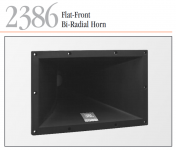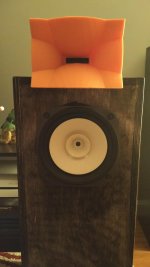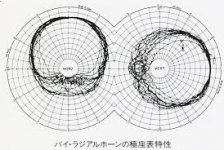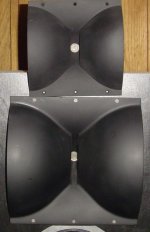But the mouth reflections from the horn edge is a deal breaker to me.
I like the contour of horn in post #259, some would say it places the centers too far apart.
I like the contour of horn in post #259, some would say it places the centers too far apart.
Is it possible someone can build me a horn that will go down to 300hz for a BMS 4594HE 1.4" coaxial compression driver
@Patrick
Have your initial thinkings about biradial horns leaded to an preliminary design you can show here?
I have searched about the math of these horns and if there is an assumption of surface propagation or wavefront following some destinct equations but did not found sources which can be used to program them.
br!
Bernd
Have your initial thinkings about biradial horns leaded to an preliminary design you can show here?
I have searched about the math of these horns and if there is an assumption of surface propagation or wavefront following some destinct equations but did not found sources which can be used to program them.
br!
Bernd
In Bjørn Kolbrek book you have a lot of information about it, the 2386,mmm... not CD and not for a room between 2.5m to 5/6m, it's a 40° horn.
For a horn with a 6.5 or 8" you can use 90° OS or PT waveguide, the Ath4 of Mabat is very good for this, I love OS for this.
When you need a bigger horn for 12/14/15" woofer, still in 90°, it become too big and loose his CD behavior, at this moment it's better (IMHO) to use Biradia hyperbolic with fin, like Arai 290 or 480 :
=> Arai Horn Website <=
I work on a prototype adapted to 1.4" driver compression with a better polar response than Arai horns.
For a horn with a 6.5 or 8" you can use 90° OS or PT waveguide, the Ath4 of Mabat is very good for this, I love OS for this.
When you need a bigger horn for 12/14/15" woofer, still in 90°, it become too big and loose his CD behavior, at this moment it's better (IMHO) to use Biradia hyperbolic with fin, like Arai 290 or 480 :
=> Arai Horn Website <=
I work on a prototype adapted to 1.4" driver compression with a better polar response than Arai horns.
For a horn with a 6.5 or 8" you can use 90° OS or PT waveguide, the Ath4 of Mabat is very good for this, I love OS for this.
When you need a bigger horn for 12/14/15" woofer, still in 90°, it become too big and loose his CD behavior ...
That's a curious statement since I find the opposite. As an OS waveguide gets larger its CD bandwidth will increase, not decrease. With OS waveguides bigger is always better.
The HFs are unaffected by size of the mouth, only the throat, and as the mouth gets bigger its CD behavior goes ever lower in frequency.
Ok, I take a shortcut because on hyperbolic horn the more it's big/deep the more it become "narrow" on polar response in HFs.
What do you think about OS on the side and Hyperbolic in V ? more or less like the GT sound GH-301AS ?
What do you think about OS on the side and Hyperbolic in V ? more or less like the GT sound GH-301AS ?
All devices "narrow" at HFs, but OS waveguide do so less than others. I don't believe in horns with diffraction slots. To many reflections.
yes, but less with fins for narrow polar response in HFs.
So the limiting factor for big OS waveguide is "only" the throat impedance ?
Bjorn give an equation for Fc in OS waveguide depends on throat radius and coverage angle.
Yes OS is very good in terms of directivity and also easier to produce 🙂 (in CAD soft and with industrial CNC, 3D printer...).
Diffraction dues to fin are located very hight in HFs and a little bit flooded by reverberant field (as we listen in a room) I thinks that the mid-range beaming due to abrupt end of profile seems to be more problematic, it become close do 2/2.5khz with biradial horn but it can be improve, as on every horns in fact (like in ath4 tool and Clothoïde for OS).
So the limiting factor for big OS waveguide is "only" the throat impedance ?
Bjorn give an equation for Fc in OS waveguide depends on throat radius and coverage angle.
Yes OS is very good in terms of directivity and also easier to produce 🙂 (in CAD soft and with industrial CNC, 3D printer...).
Diffraction dues to fin are located very hight in HFs and a little bit flooded by reverberant field (as we listen in a room) I thinks that the mid-range beaming due to abrupt end of profile seems to be more problematic, it become close do 2/2.5khz with biradial horn but it can be improve, as on every horns in fact (like in ath4 tool and Clothoïde for OS).
Hyperbolic can make a mess , not the best choice for high frequencies but they are very good working with upper bass.
Hyperbolic can make a mess , not the best choice for high frequencies but they are very good working with upper bass.
yes they can, but they not all are a mess in HFs, it depends of the size of the throat, the good respect of fins position, if there is a pinch at the throat (diffraction horn)...
In one word it depends of the conception, it's a complex horn, I have tested several of them, all were different in HFs due to specifics choices that have a huge impact on it.
Some are (IMHO) unlistenable in HFs, others yes and even very good.
Is that 3D printed? And an AMT/ribbon in there?
Yep, each horn took about 17 hours to print in PLA with a 25% grid infill and 3 0.45mm perimeters to make it plenty sturdy. The transducer is a ribbon from a Fountek NeoCD3.5H. I replaced the stock CD horn with the printed one for a little experiment, works surprisingly well. It's currently used very high up (~15k first-order) and fills in the upper treble where the Fostex driver wanes in response, so the next order of business will be a full 2.9kHz two-way third-order Bessel crossover to see how the horn behaves with the current loading.
DIY Bi-radial
That is a 4425 MKII that was built exclusively for the asian markets. The absence of a hard diffraction slot in a JBL model seems to be both surprising and attractive. From the numerous youtube videos on this model, its off-axis performance appears to be fairly good.
I am attaching some information on this model that I was able to pick up from one such video. Although it is in Japanese (I think) the pictures would still be useful to many. However, it would be great if somebody could translate the accompanying text material as well.
Patrick Bateman, what kind of polar performance can be expected from the blue slotless bi-radial horn shown in the post#3? It would be nice if it could rival the JBL MKII. I ask this mainly because this kind of horn appears to be reasonably easier to build, when compared to many others.
Thanks.
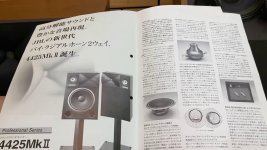
You could leave it at this, and have something similar to the older biradials:
That is a 4425 MKII that was built exclusively for the asian markets. The absence of a hard diffraction slot in a JBL model seems to be both surprising and attractive. From the numerous youtube videos on this model, its off-axis performance appears to be fairly good.
I am attaching some information on this model that I was able to pick up from one such video. Although it is in Japanese (I think) the pictures would still be useful to many. However, it would be great if somebody could translate the accompanying text material as well.
Patrick Bateman, what kind of polar performance can be expected from the blue slotless bi-radial horn shown in the post#3? It would be nice if it could rival the JBL MKII. I ask this mainly because this kind of horn appears to be reasonably easier to build, when compared to many others.
Thanks.

Last edited:
JBL 2344 from the looks of it.A slightly better version of the polar plots. Does anyone know how deep the horn is ?
Rob 🙂
http://www.audioheritage.org/vbulle...2-Improvements-in-Monitor-Loudspeaker-Systems
I like the look of the horn, perhaps a bit of bubble at the throat, but should be low in reflections, except at end of mouth.......
I don't have a viewer to see your file. Here is a size comparison between 2342 and 2344. The plots in the attached PDF are from a 2344. They look identical to me and with the size difference and slot differences the polar S/B different.Isn't it supposed to be the 2342, as the dimensions of the 2344 (from JBL CAD data) are somewhat larger than what they're supposed to be ? Attached is a 3D drawing of the 2344 for reference (please rename to *.DXF after downloading).
Rob 🙂
Attachments
- Home
- Loudspeakers
- Multi-Way
- How to Make a New Wave Biradial Horn
